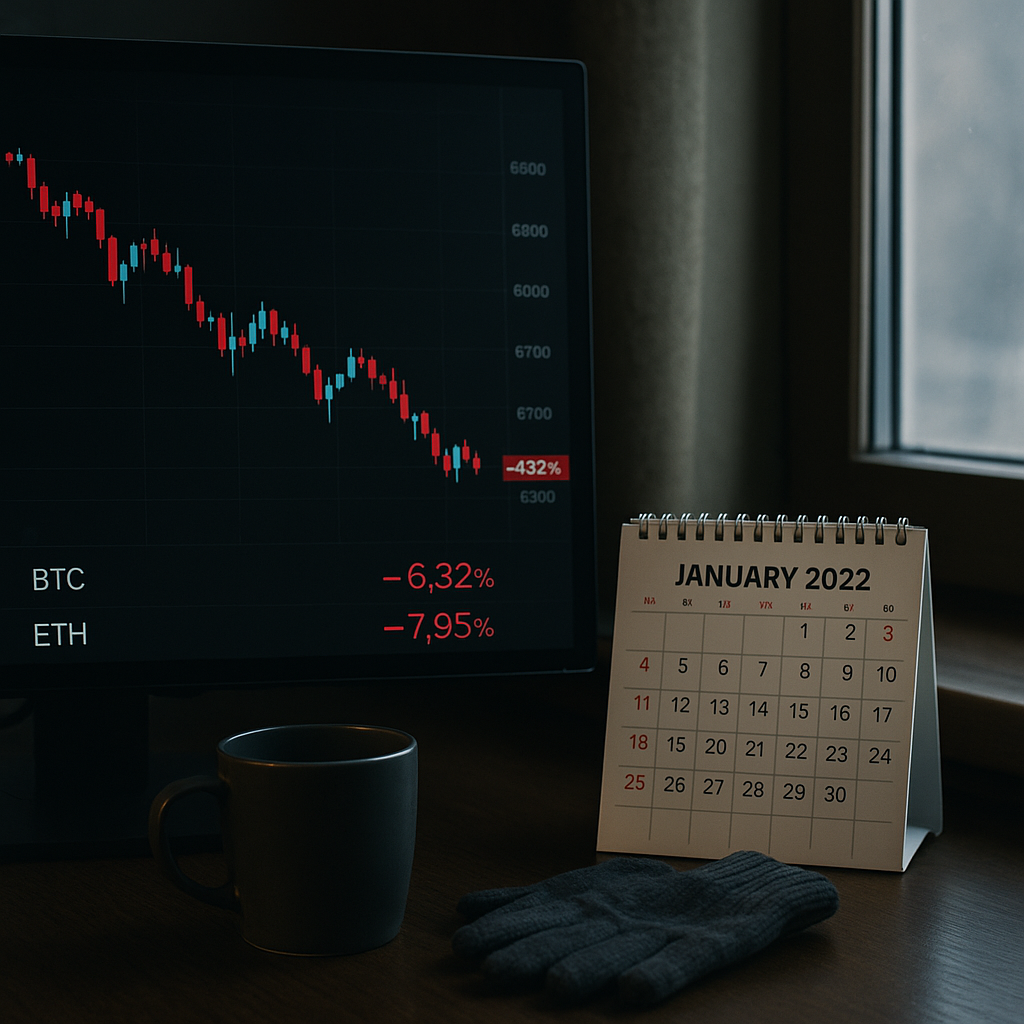Crypto Markets Start 2022 in Bearish Downtrend
The new year hasn’t brought relief to cryptocurrency investors. Instead, January 2022 has begun with significant losses across all major digital assets, extending the bearish momentum that closed out the previous year.
Bitcoin, Ethereum, and most altcoins are trading well below their all-time highs, while investor sentiment has turned cautious amid macroeconomic shifts and tightening monetary policy.
A Rough Start: Market Performance So Far
As of mid-January:
-
Bitcoin has dropped below $42,000, down nearly 40% from its all-time high of $69,000 in November.
-
Ethereum is trading near $3,200, down over 35% from its peak.
-
Solana (SOL), Cardano (ADA), and Avalanche (AVAX) have experienced even sharper declines, some losing over 50% from recent highs.
-
The total crypto market cap has fallen below $2 trillion for the first time since September 2021.
This marks one of the weakest January starts for crypto markets in recent memory.
What’s Causing the January 2022 Downtrend?
Multiple overlapping factors are dragging markets lower:
-
Federal Reserve Signals Rate Hikes
In early January, the Fed indicated plans to raise interest rates multiple times in 2022 to fight persistent inflation. Risk assets — including crypto — have responded with sharp selloffs. -
Quantitative Tightening (QT)
The Fed also discussed reducing its balance sheet, effectively pulling liquidity out of the system. This has rattled markets that thrived under easy money. -
Weak Tech and Growth Stocks
Crypto is increasingly correlated with tech equities. The Nasdaq Composite dropped over 5% in the first two weeks of 2022, dragging crypto along. -
Global Uncertainty
Continued COVID-19 disruptions, geopolitical tension (notably around Russia-Ukraine), and supply chain issues have added to investor anxiety. -
Profit-Taking and Fear
Many traders and institutions are cashing out gains from 2021, while fear of further downside is fueling panic selling in low-liquidity conditions.
Bitcoin’s Key Levels and Sentiment Shift
Bitcoin’s failure to hold above $45,000 has led to renewed bearish outlooks. Key support and resistance zones in January include:
-
$40,000: A critical psychological support
-
$38,000: Strong previous support from September 2021
-
$30,000: The major floor tested during the May–July 2021 correction
Sentiment, as measured by the Crypto Fear & Greed Index, has dropped into the “Extreme Fear” zone — a reflection of widespread caution.
Altcoins Suffer More in Bearish Momentum
Historically, altcoins tend to underperform during market downturns — and this pattern is repeating in January:
-
Meme coins like Dogecoin and Shiba Inu have retraced 60–70% from their highs.
-
DeFi tokens (AAVE, UNI, SUSHI) are seeing significant outflows.
-
Layer 1 competitors (e.g., Solana, Terra, Avalanche) are under pressure as investors rotate into more defensive positions.
While some see these dips as buying opportunities, others warn that altcoins could still fall further if Bitcoin drops below critical levels.
NFTs and Metaverse Tokens Hold Ground — For Now
Interestingly, some niche sectors are showing relative strength:
-
NFT marketplaces like OpenSea have seen record transaction volumes in early January.
-
Metaverse-related tokens (MANA, SAND) are holding better than DeFi or meme coins, likely due to continued media and institutional interest.
However, if broader weakness continues, even these sectors may not be immune.
Institutional Behavior and Derivatives Trends
Institutional flows have slowed in January. According to CoinShares:
-
Digital asset investment products saw weekly outflows of over $200 million.
-
Futures and options markets are showing declining open interest, signaling reduced speculative activity.
Leverage is also being flushed out. A series of liquidations on leveraged longs contributed to sharp daily drops across January’s first two weeks.
Are We in a Bear Market?
There’s growing debate over whether this is a short-term correction or the beginning of a prolonged crypto bear market.
Bearish indicators include:
-
Lower highs on Bitcoin’s daily and weekly charts
-
Weak trading volume during rallies
-
Failure to break key resistance levels
-
Broad outflows from crypto funds
Bullish counterpoints include:
-
Long-term holders are still accumulating
-
On-chain metrics show strong fundamentals (e.g., active addresses, hash rate)
-
Previous cycle patterns suggest corrections of 30–50% are normal within uptrends
The next few weeks will be critical in determining whether a bounce or breakdown is more likely.
Strategies for Navigating the Downtrend
In this environment, investors should:
-
Avoid Panic Selling
Selling into fear often locks in losses. If fundamentals remain strong, dips may be opportunities. -
Scale In Cautiously
Use dollar-cost averaging (DCA) to reenter gradually rather than all at once. -
Focus on High-Conviction Assets
Blue-chip cryptos like BTC and ETH tend to recover faster than speculative coins. -
Watch Key Macro Events
Fed meetings, inflation data, and geopolitical news will heavily influence risk sentiment. -
Review Your Risk Profile
If you’re overexposed, consider trimming positions or rebalancing toward safer allocations.
Conclusion: A Challenging but Not Unprecedented Start
January 2022 has started on a rough note for crypto investors, but this isn’t the first time the market has faced turbulence. Each cycle has seen pullbacks, resets, and consolidations — followed by periods of explosive growth.
Whether this is the start of a longer correction or just a reset after a historic year remains to be seen. But for long-term believers in digital assets, this phase is a reminder: volatility is the price of opportunity.
Stay informed, stay patient — and be ready for what comes next.
